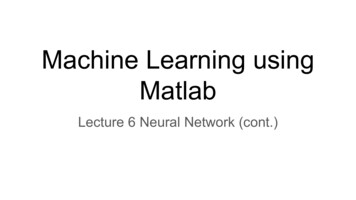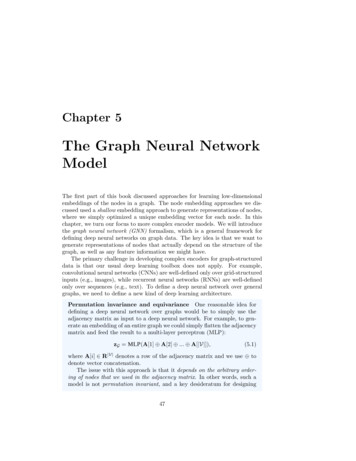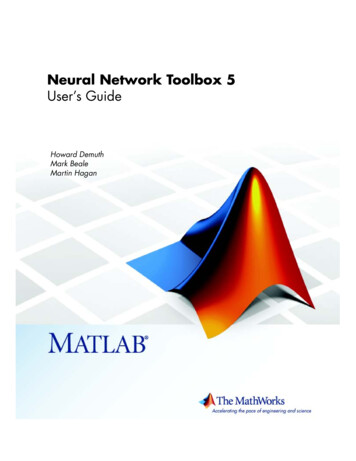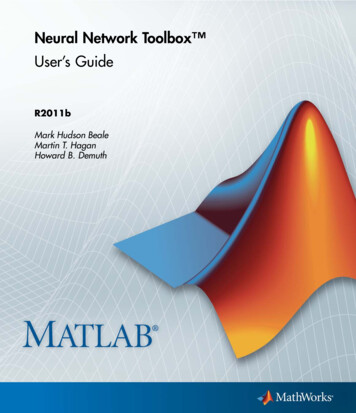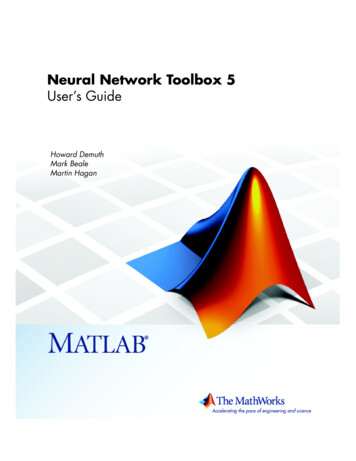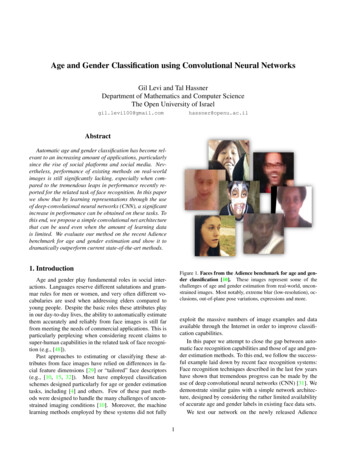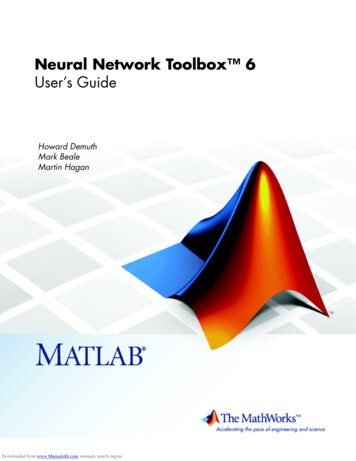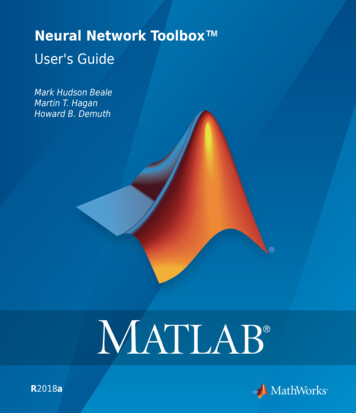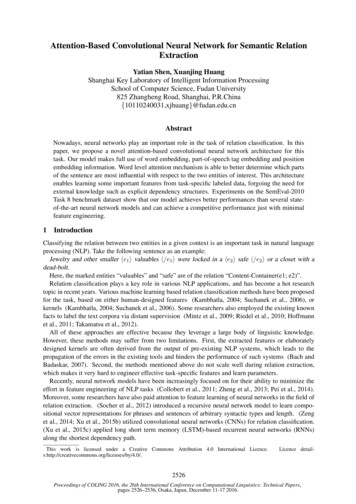
Transcription
Attention-Based Convolutional Neural Network for Semantic RelationExtractionYatian Shen, Xuanjing HuangShanghai Key Laboratory of Intelligent Information ProcessingSchool of Computer Science, Fudan University825 Zhangheng Road, Shanghai, tNowadays, neural networks play an important role in the task of relation classification. In thispaper, we propose a novel attention-based convolutional neural network architecture for thistask. Our model makes full use of word embedding, part-of-speech tag embedding and positionembedding information. Word level attention mechanism is able to better determine which partsof the sentence are most influential with respect to the two entities of interest. This architectureenables learning some important features from task-specific labeled data, forgoing the need forexternal knowledge such as explicit dependency structures. Experiments on the SemEval-2010Task 8 benchmark dataset show that our model achieves better performances than several stateof-the-art neural network models and can achieve a competitive performance just with minimalfeature engineering.1IntroductionClassifying the relation between two entities in a given context is an important task in natural languageprocessing (NLP). Take the following sentence as an example:Jewelry and other smaller he1 i valuables h/e1 i were locked in a he2 i safe h/e2 i or a closet with adead-bolt.Here, the marked entities “valuables” and “safe” are of the relation “Content-Container(e1; e2)”.Relation classification plays a key role in various NLP applications, and has become a hot researchtopic in recent years. Various machine learning based relation classification methods have been proposedfor the task, based on either human-designed features (Kambhatla, 2004; Suchanek et al., 2006), orkernels (Kambhatla, 2004; Suchanek et al., 2006). Some researchers also employed the existing knownfacts to label the text corpora via distant supervision (Mintz et al., 2009; Riedel et al., 2010; Hoffmannet al., 2011; Takamatsu et al., 2012).All of these approaches are effective because they leverage a large body of linguistic knowledge.However, these methods may suffer from two limitations. First, the extracted features or elaboratelydesigned kernels are often derived from the output of pre-existing NLP systems, which leads to thepropagation of the errors in the existing tools and hinders the performance of such systems (Bach andBadaskar, 2007). Second, the methods mentioned above do not scale well during relation extraction,which makes it very hard to engineer effective task-specific features and learn parameters.Recently, neural network models have been increasingly focused on for their ability to minimize theeffort in feature engineering of NLP tasks (Collobert et al., 2011; Zheng et al., 2013; Pei et al., 2014).Moreover, some researchers have also paid attention to feature learning of neural networks in the field ofrelation extraction. (Socher et al., 2012) introduced a recursive neural network model to learn compositional vector representations for phrases and sentences of arbitrary syntactic types and length. (Zenget al., 2014; Xu et al., 2015b) utilized convolutional neural networks (CNNs) for relation classification.(Xu et al., 2015c) applied long short term memory (LSTM)-based recurrent neural networks (RNNs)along the shortest dependency path.This work is licensed under a Creative Commons Attribution 4.0 International .0/.Licence detail-2526Proceedings of COLING 2016, the 26th International Conference on Computational Linguistics: Technical Papers,pages 2526–2536, Osaka, Japan, December 11-17 2016.
We have noticed that these neural models are all designed as the way that all words are equally important in the sentence, and contribute equally to the representation of the sentence meaning. However,various situations have shown that it is not always the case. For example,“The he1 i women h/e1 i that caused the he2 i accident h/e2 i was on the cell phone and ran thru theintersection without pausing on the median.”, where the type of relation is “Cause-Effect(e2,e1)”.Obviously, not all words contribute equally to the representation of the semantic relation. In thissentence, “caused” is of particular significance in determining the relation “Cause-Effect”, but “phone”is less correlated with the semantic of the relation of “Cause-Effect”. So how to identify critical cueswhich determine the primary semantic information is an important task.If the relevance of words with respect to the target entities is effectively captured, we can find criticalwords which determine the semantic information. Hence, we propose to introduce the attention mechanism into a convolution neural network (CNN) to extract the words that are important to the meaning ofthe sentence and aggregate the representation of those informative words to form a sentence vector. Thekey contributions of our approach are as follows:1. We propose a novel convolution neural network architecture that encodes the text segment to itssemantic representation. Compared to existing neural relation extraction models, our model can makefull use of the word embedding, part-of-speech tag embedding and position embedding.2. Our convolution neural network architecture relies on the word level attention mechanism to chooseimportant information for the semantic representation of the relation. This makes it possible to detectmore subtle cues despite the heterogeneous structure of the input sentences, enabling it to automaticallylearn which parts are relevant to the given class.3. Experiments on the SemEval-2010 Task 8 benchmark dataset show that our model achieves better performance with an F1 score of 85.9% than previous neural network models, and can achieve acompetitive performance with an F1 score of 84.3% just with minimal feature engineering.2Related WorksA variety of learning paradigms have been applied to relation extraction. As mentioned earlier, supervised methods have shown to perform well in this task. In the supervised paradigm, relation classificationis considered as a multi-classification problem, and researchers concentrate on extracting complex features, either feature-based or kernel-based. (Kambhatla, 2004; Suchanek et al., 2006) converted theclassification clues (such as sequences and parse trees) into feature vectors. Various kernels, such asthe convolution tree kernel (Qian et al., 2008), subsequence kernel (Mooney and Bunescu, 2005) anddependency tree kernel (Bunescu and Mooney, 2005), have been proposed to solve the relation classification problem. (Plank and Moschitti, 2013) introduced semantic information into kernel methods inaddition to considering structural information only. However, the reliance on manual annotation, whichis expensive to produce and thus limited in quantity has provided the impetus for distant-supervision(Mintz et al., 2009; Riedel et al., 2010; Hoffmann et al., 2011; Takamatsu et al., 2012).With the recent revival of interest in deep neural networks, many researchers have concentrated onusing deep networks to learn features. In NLP, such methods are primarily based on learning a distributedrepresentation for each word, which is also called a word embedding (Turian et al., 2010). (Socher etal., 2012) presented a recursive neural network (RNN) for relation classification to learn vectors in thesyntactic tree path connecting two nominals to determine their semantic relationship. (Hashimoto et al.,2013) also employed a neural relation extraction model allowing for the explicit weighting of importantphrases for the target task. (Zeng et al., 2014) exploited a convolutional deep neural network to extractlexical and sentence level features. These two levels of features were concatenated to form the finalfeature vector. (Ebrahimi and Dou, 2015) rebuilt an RNN on the dependency path between two markedentities. (Xu et al., 2015b) used the convolutional network and proposed a ranking loss function withdata cleaning. (Xu et al., 2015c) leveraged heterogeneous information along the shortest dependencypath between two entities. (Xu et al., 2016) proposed a data augmentation method by leveraging thedirectionality of relations.Another line of research is the attention mechanism for deep learning. (Bahdanau et al., 2014) pro2527
OutputConcatenationFeature Sentence Convolution Attention-based h his [feet]e1 have been moving into the [ball]e2Figure 1: Architecture of the attention-based convolution neural network.posed the attention mechanism in machine translation task, which is also the first use of it in natural language processing. This attention mechanism is used to select the reference words in the original languagefor words in the foreign language before translation. (Xu et al., 2015a) used the attention mechanismin image caption generation to select the relevant image regions when generating words in the captions.Further uses of the attention mechanism included paraphrase identification (Yin et al., 2015), documentclassification (Yang et al., 2016), parsing (Vinyals et al., 2015), natural language question answering(Sukhbaatar et al., 2015; Kumar et al., 2015; Hermann et al., 2015) and image question answering (Linet al., 2015). (Wang et al., 2016) introduced attention mechanism into relation classification which reliedon two levels of attention for pattern extraction. In this paper, we will explore the word level attentionmechanism in order to discover better patterns in heterogeneous contexts for the relation classificationtask.3MethodologyGiven a set of sentences x1 , x2 , .xn and two corresponding entities, our model measures the probabilityof each relation r. The architecture of our proposed method is shown in Figure 1. Here, feature extractionis the main component, which is composed of sentence convolution and attention-based context selection.After feature extraction, two kinds of vectors – the sentence convolution vector and the attention-basedcontext vector, are generated for semantic relation classification. Sentence Convolution: Given a sentence and two target entities, a convolutional neutral network(CNN) is used to construct a distributed representation of the sentence. Attention-based Context Selection: We use word-level attention to select relevant words withrespect to the target entities.3.13.1.1Sentence ConvolutionInput of ModelWord Embeddings. Figure 2 shows the architecture of our convolution neural network. In the wordrepresentation layer, each input word token is transformed into a vector by looking up word embeddings.(Collobert et al., 2011) reported that word embeddings learned from significant amounts of unlabeleddata are far more satisfactory than the randomly initialized embeddings. Although it usually takes along time to train the word embeddings, there are many freely available trained word embeddings. Acomparison of the available word embeddings is beyond the scope of this paper. Our experiments directlyutilize the embeddings trained by the CBOW model on 100 billion words of Google News (Mikolov etal., 2013).2528
Sentence Convolution FeatureConvolutionMax PoolingWindows ProcessingWord EmbeddingPosition EmbeddingPOS EmbeddingFigure 2: Architecture of convolution neural network.Position Embeddings. In the task of relation extraction, the words close to the target entities areusually more informative in determining the relation between entities. Similar to (Zeng et al., 2014), weuse position embeddings specified by entity pairs. It can help the CNN to keep track of how close eachword is to the head or the tail entity, which is defined as the combination of the relative distances fromthe current word to the head or the tail entity. For example,“The he1 i game h/e1 i was sealed in the original he2 i packing h/e2 i unopened and untouched.”In this sentence, the relative distance from the word “sealed” to the head entity “game” is 2 and thetail entity “packing” is 4. According to the above rule, we can obtain the relative distance from everyword in the above sentence to each entity. We first create two relative distance files of entity e1 andentity e2 . Then, we use the CBOW model to pretrain position embeddings on two relative distance filesrespectively (Mikolov et al., 2013). The dimension of position embedding is set 5.Part-of-speech tag Embeddings. Our word embeddings are obtained from the Google News corpus,which is slightly different to the relation classification corpus. We deal with this problem by allying eachinput word with its POS tag to improve the robustness. In our experiment, we only take into use a coarsegrained POS category, containing 15 different tags. We use the Stanford CoreNLP Toolkit to obtain thepart-of-speech tagging (Manning et al., 2014) . Then we pretrain the embeddings by the CBOW modelon the taggings, and the dimension of part-of-speech tag embedding is set 10.Finally, we concatenate the word embedding, position embedding, and part-of-speech tag embeddingof each word and denote it as a vector of sequence w [W F, pF, P OSF ].3.1.2 Convolution, Max-pooling and Non-linear LayersIn relation extraction, one of the main challenges is that, the length of the sentences is variable and important information can appear anywhere. Hence, we should merge all local features and perform relationprediction globally. Here, we use a convolutional layer to merge all these features. The convolutionallayer first extracts local features with a sliding window of length l over the sentence. We assume thatthe length of the sliding window l is 3. Then, it combines all local features via a max-pooling operationto obtain a fixed-sized vector for the input sentence. Since the window may be outside of the sentenceboundaries when it slides near the boundary, we set special padding tokens for the sentence. It meansthat we regard all out-of-range input vectors wi (i 1 or i m) as zero vector.Let xi Rk be the k-dimensional input vector corresponding to the ith word in the sentence. Asentence of length n (padded where necessary) is represented as:x1:n x1 x2 x3 . xn(1)where is the concatenation operator. Let xi:i j refer to the concatenation of words xi , xi 1 , ., xi j .A convolution operation involves a filter w Rhk , which is applied to a window of h words to producea new feature. For example, a feature ci is generated from a window of words xi:i h 1 by2529
Attention LayerAttention Weights Computation UnitAttention-based Context FeatureEntity Vectorɑ1WordEmbeddingWord VectorEach Word in Sentenceɑ2ɑ3ɑ4AttentionWeightsEach Entity in n WeightsComputation UnitBoth his [feet]e1 have been moving into the [ball]e2Hidden Layer(a) Attention weights computation unit.(b) Attention layer network.Figure 3: Architecture of attention layer network.ci f (w · xi:i h 1 )(2)Here f is a non-linear function such as the hyperbolic tangent. This filter is applied to each possiblewindow of words in the sentence {x1:h , x2:h 1 , ., xn h 1:n } to produce a feature map:c [c1 , c2 , ., cn h 1 ](3)with c Rn h 1 . We then apply a max-overtime pooling operation over the feature map and take themaximum value ĉ max{c} as the feature. The idea is to capture the most important feature – one withthe highest value – for each feature map. This pooling scheme naturally deals with variable sentencelengths.3.2Attention-based Context SelectionOur attention model is applied to a rather different kind of scenario, which consist of heterogeneousobjects, namely a sentence and two entities. So we seek to give our model the capability to determinewhich parts of the sentence are most influential with respect to the two entities of interest. For instance,“That coupled with the he1 i death h/e1 i and destruction caused by the he2 i storm h/e2 i was a verytraumatic experience for these residents.”.Here, the type of relation is “Cause-Effect(e2,e1)”.In this sentence, the non-entity word “caused” is of particular significance in determining the relation“Cause-Effect”. Fortunately, we can exploit the fact that there is a salient connection between “caused”and “death”. We introduce a word attention mechanism to quantitatively model such contextual relevanceof words with respect to the target entities.In order to calculate the weight of each word in the sentence, we need to feed each word in thesentence and each entity to a multilayer perceptron (MLP). The network structure of the attention weightcomputation is shown in Figure 3 (a).Assume that each sentence contains T words. wit with t [1, T ] represents the words in the ith sentence. eij with j [1, 2] represents the jth entity in the ith sentence. We concatenate the representationof entity eij and the representation of word wit to get a new representation of word t, i.e., hjit [wit , eij ].ujit quantifies the degree of relevance of the tth word with respect to the jth entity in the ith sentence.This relevance scoring function is computed by the MLP network between the respective embeddings ofthe word wit and the entity eij . We named the degree of relevance as the word attention weight, namely,ujit . The calculation procedure of ujit is as follows:hjit [wit , eij ](4)ujit Wa [tanh(Wwe hjit bwe )] ba(5)2530
jThe output of the attention MLP network is ujit . Now we can get a normalized importance weight αitthrough a softmax function.exp(ujit )jαit P(6)jt exp(uit )The architecture of our proposed attention layer is shown in Figure 3 (b). After that, we compute thesentence context vector sij about entity j as a weighted sum of the word in the sentence i based on theweights as follows:sij Xtjαitwit(7)The context vector sij can be seen as a high level representation of a fixed query “what is the informative word” over the words. The weight of attention MLP network is randomly initialized and jointlylearned during the training process.3.3MLP LayerAt last, we can obtain the output of three networks, which includes the result of convolution network,and the sentence context vectors of the two entities. We then concatenate all three output vectors into afixed-length feature vector.The fixed length feature vector is fed to a multi-layer perceptron (MLP), which is shown in Figure 1.More specifically, first, the vector obtained is fed into a full connection hidden layer to get a more abstractive representation, and then, this abstractive representation is connected to the output layer. For the taskof classification, the outputs are the probabilities of different classes, which is computed by a softmaxfunction after the fully-connected layer. We name the entire architecture of our model Attention-CNN.3.4Model TrainingThe relation classification model proposed here using attention-based convolutional neural network couldbe stated as a parameter vector θ. To obtain the conditional probability p(i x, θ), we apply a softmaxoperation over all relation types:eoip(i x, θ) Pn(8)okk 1 eGiven all the T training examples (x(i) ; y (i) ), we can then write down the log likelihood of the parameters as follows:TXJ (θ) log p(y i xi , θ)(9)i 1To compute the network parameter of θ, we maximize the log likelihood J using stochastic gradientdescent (SGD). θ are randomly initialized. We implement the back-propagation algorithm and apply thefollowing update rule: log p(y x, θ)θ θ λ(10) θMinibatch sizeWord embedding sizeWord Position Embedding sizePart-of-speech tag EmbeddingsWord Window sizeConvolution sizeLearning rate3230051031000.02Table 1: Hyperparameters of our model2531
44.1ExperimentsDataset and Evaluation MetricsWe evaluated our model on the SemEval-2010 Task 8 dataset, which is an established benchmark forrelation classification (Hendrickx et al., 2009). The dataset contains 8000 sentences for training, and2717 for testing. We split 1000 samples out of the training set for validation.The dataset distinguishes 10 relations, and the former 9 relations are directed, whereas the “Other”class is undirected. In our experiments, We do not distinguish the direction of the relationship. Tocompare our results with those obtained in previous studies, we adopt the macro-averaged F1-score inour following experiments.4.2Parameter SettingsIn this section, we experimentally study the effects of different kinds of parameters in our proposedmethod: Word embedding size, Word Position Embedding size, Word Window size, Convolution size,Learning rate, and Minibatch size. For the initialization of the word embeddings used in our model, weuse the publicly available word2vec vectors that were trained on 100 billion words from Google News.Words not present in the set of pre-trained words are initialized randomly. The other parameters areinitialized by randomly sampling from the uniform distribution in [-0.1,0.1].ModelSVMRNNMVRNNCNN(Zeng et al., 2014)FCMCR-CNNSDP-LSTMAttention-CNNFeature SetsPOS, stemming, syntactic pattern, WordNet POS, NER, WordNet POS, NER, WordNet WordNet, words around nominalsdepedency parsing, NER WordNet, words around nominalsPOS, WordNet, grammar relation WordNet, words around 84.385.9Table 2: Comparison of the proposed method with existing methods in the SemEval-2010 Task 8 dataset.For other hyperparameters of our proposed model, we take those hyperparameters that achieved thebest performance on the development set. The final hyper-parameters are shown in Table 1.4.3Results of Comparison ExperimentsTo evaluate the performance of our automatically learned features, we select six approaches as competitors to be compared with our method.Table 2 summarizes the performances of our model, SVM (Hendrickx et al., 2009), RNN, MVRNN (Socher et al., 2012), CNN (Zeng et al., 2014), FCM (Gormley et al., 2015), CR-CNN (Xu etal., 2015b), and SDP-LSTM (Xu et al., 2015c). All of the above models adopt word embedding as representation except SVM. For fair comparison among the different model, we also add two types of lexicalfeatures, WordNet hypernyms and words around nominals, as part of the fixed length feature vector tothe MLP layer.We can observe in Table 2 that, Attention-CNN, without extra lexical features such as WordNet andwords around nominals, still outperforms previously reported best systems of CR-CNN and SDP-LSTMwith F1 of 83.7%, though both of which have taken extra lexical features into account. It shows thatour method can learn a robust and effective relation representation. When added with the same lexicalfeatures, our Attention-CNN model obtains the result of 85.9%, significantly better than CR-CNN and2532
SDP-LSTM. In general, richer feature sets lead to better performance. Such neural models as RNN,MVRNN, CR-CNN and SDP-LSTM can automatically learn valuable features, and all of these models heavily depend on the result of the syntactic parsing. However, the error of syntactic parsing willinevitably inhibit the ability of these methods to learn high quality features.Similarly, Attention-CNN, CNN, and CR-CNN all apply convolution neural network to the extractionof sentence features, but we can see from Table 2 that Attention-CNN yield a better performance of84.3%, compared with CNN and CR-CNN. One of the reason is that the input of the three models aredifferent. Our model uses word embeddings, position embeddings, part-of-speech embeddings as input.CNN also leverages position embeddings and lexical features. CR-CNN makes use of heterogeneousinformation along the shortest dependency path between two entities. Our experiments verify that thepart-of-speech embeddings used by us contain rich semantic information. On the other hand, our proposed Attention-CNN model can still yield higher F1 without prior NLP knowledge. The reason shouldbe due to that word level attention mechanism is able to better choose which parts of the sentence aremore discriminative with respect to the two entities of interest.Feature SetsWF pF POSF WA WA (Lexical Feature)F174.580.782.684.385.9Table 3: Score obtained for various sets of features on the test set. The bottom portion of the table showsthe best combination of all the features.4.4Effect of Different Feature ComponentOur network model primarily contains four sets of features, “Word Embeddings (WF)”,“Position Embeddings (pF)”,“Part-of-speech tag Embeddings (POSF)”, and “Word Attention (WA)”. We performedablation tests on the four sets of features in Table 3 to determine which type of features contributed themost. From the results we can observe that our learned position embedding features are effective for relation classification. The F1-score is improved remarkably when position embedding features are added.POS tagging embeddings are comparatively more informative, which can boost the F1 by 1.9%. Thesystem achieves approximately 2.3% improvements when adding Word Attention. When all features arecombined, we achieve the best result of 85.9%.4.5Visualization of AttentionIn order to validate whether our model is able to select informative words in a sentence or not, wevisualize the word attention layers in Figure 4 for several data from test sets.Every line in Figure 4 shows a sentence. The size of a word denotes the importance of it. We normalizethe word weight to make sure that only important words are emphasized. Given the following sentenceas an example,“The burst has been caused by water hammer pressure.”we can find that the word “caused” was assigned the highest attention score, while words such as“burst” and “pressure” also are important. This makes sense in light of the ground-truth labeling as a“Cause-Effect” relationship. Additionally, we observe that words like “The”, “has” and “by” have lowattention scores. These are indeed rather irrelevant with respect to the “Component-Whole” relationship.5ConclusionIn this paper, we propose an attention-based convolutional neural network architecture for semanticrelation extraction. Here, the convolutional neural network architecture is used to extract the features2533
RelationInstrument-AgencyRepresentation of Word Attention WeightThe author of a keygen uses adisassembler to look at the rawassembly codeMessage-TopicCause-EffectThe Pulitzer Committee issues an officialawardcitation explaining the reasons for theThe burst has been caused by water hammerpressurenetworks have moved into high-definition broadcastInstrument-AgencyEven commercialComponent-WholeThe girl showed a photoof apple tree blossom on a fruit tree in the CentralValleyMember-CollectionThey tried an assault of theirown an hour later, with two columns of sixteen tanksbacked by a battalion of Panzer grenadiersFigure 4: Visualization of Attention.of the sentence. Our model can make full use of word embedding, part-of-speech tag embedding andposition embedding information. Meanwhile, word level attention mechanism is able to better determinewhich parts of the sentence are most influential with respect to the two entities of interest. Experimentson the SemEval-2010 Task 8 benchmark dataset show that our model achieves better performances thanseveral state-of-the-art systems.In the future, we will focus on exploring better neural network structure about feature extraction inrelation extraction. Meanwhile, because end-to-end relation extraction is also an important problem, wewill seek better methods for completing entity and relation extraction jointly.AcknowledgementsWe would like to thank the anonymous reviewers for their valuable comments. This work was partiallyfunded by National Natural Science Foundation of China (No. 61532011 and 61472088), the NationalHigh Technology Research and Development Program of China (No. 2015AA015408).ReferencesNguyen Bach and Sameer Badaskar. 2007. A review of relation extraction. Literature review for Language andStatistics II.Dzmitry Bahdanau, Kyunghyun Cho, and Yoshua Bengio. 2014. Neural machine translation by jointly learning toalign and translate. arXiv preprint arXiv:1409.0473.Razvan C Bunescu and Raymond J Mooney. 2005. A shortest path dependency kernel for relation extraction. InProceedings of the conference on Human Language Technology and Empirical Methods in Natural LanguageProcessing, pages 724–731. Association for Computational Linguistics.Ronan Collobert, Jason Weston, Léon Bottou, Michael Karlen, Koray Kavukcuoglu, and Pavel Kuksa. 2011.Natural language processing (almost) from scratch. The Journal of Machine Learning Research, 12:2493–2537.Javid Ebrahimi and Dejing Dou. 2015. Chain based rnn for relation classification. In Proceedings of the HumanLanguage Technologies: The 2015 Annual Conference of the North American Chapter of the ACL: Associationfor Computational Linguistics, pages 1244–1249.Matthew R Gormley, Mo Yu, and Mark Dredze. 2015. Improved relation extraction with feature-rich compositional embedding models. arXiv preprint arXiv:1505.02419.Kazuma Hashimoto, Makoto Miwa, Yoshimasa Tsuruoka, and Takashi Chikayama. 2013. Simple customizationof recursive neural networks for semantic relation classification. In EMNLP, pages 1372–1376.Iris Hendrickx, Su Nam Kim, Zornitsa Kozareva, Preslav Nakov, Diarmuid Ó Séaghdha, Sebastian Padó, MarcoPennacchiotti, Lorenza Romano, and Stan Szpakowicz. 2009. Semeval-2010 task 8: Multi-way classificationof semantic relations between pairs of nominals. In Proceedings of the Workshop on Semantic Evaluations:Recent Achievements and Future Directions, pages 94–99. Association for Computational Linguistics.2534
Karl Moritz Hermann, Tomas Kocisky, Edward Grefenstette, Lasse Espeholt, Will Kay, Mustafa Suleyman, andPhil Blunsom. 2015. Teaching machines to read and comprehend. In Advances in Neural Information Processing Systems, pages 1693–1701.Raphael Hoffmann, Congle Zhang, Xiao Ling, Luke Zettlemoyer, and Daniel S Weld. 2
learn which parts are relevant to the given class. 3. Experiments on the SemEval-2010 Task 8 benchmark dataset show that our model achieves bet-ter performance with an F1 score of 85:9% than previous neural network models, and can achieve a competitive performance with an F1 score of 84:3% just with minimal feature engineering. 2 Related Works


